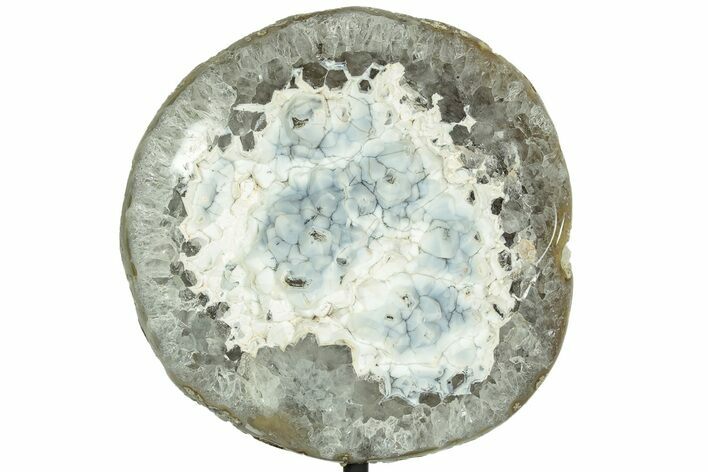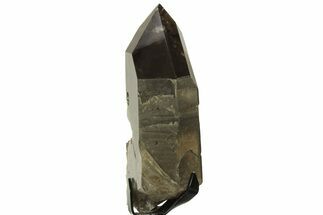This Specimen has been sold.
6.6" Agate Nodule on Metal Base - Fluorescent!
This is a gorgeous half nodule of agate from Brazil with a dense quartz crystal pocket. It has been cut and polished on a portion of the face to highlight the quartz crystals. The central pocket is coated in white and sky-blue chalcedony of which portions fluoresce a vibrant green under short-wave UV light. An awesome piece.
This nodule sits snuggly on a custom metal display stand that is not removable. A hole has been drilled into the underside of the slab and the metal pole has been inserted and glued into aforementioned hole.
This nodule sits snuggly on a custom metal display stand that is not removable. A hole has been drilled into the underside of the slab and the metal pole has been inserted and glued into aforementioned hole.
Agate is a translucent variety of microcrystalline quartz. Agate primarily forms when silica-rich fluids fill pockets within rock and/or fossils, depositing it along the walls of the rock. This process can result in banding patterns as fluid compositions and impurities change over time. These banding patterns can either form as flat layers, forming agates known as waterline agates, or as concentric layers typical of most agates, depending on the surfaces available for deposition.
Agate has also been known to fill veins or cracks in volcanic rock. Such agates, when cut transversely, exhibit a succession of parallel lines giving a banded appearance to the section. Such stones are known as banded agate, riband agate and striped agate.
Agates from Brazil are mined from decomposed volcanic ash and basalt from the late Permian age (248-275 million years old). In Rio Grande do Sul, the agate "mines" are normally just plowed fields in which loose agates are found and collected. These agates can be very colorful and polish beautifully.
Agate has also been known to fill veins or cracks in volcanic rock. Such agates, when cut transversely, exhibit a succession of parallel lines giving a banded appearance to the section. Such stones are known as banded agate, riband agate and striped agate.
Agates from Brazil are mined from decomposed volcanic ash and basalt from the late Permian age (248-275 million years old). In Rio Grande do Sul, the agate "mines" are normally just plowed fields in which loose agates are found and collected. These agates can be very colorful and polish beautifully.
SPECIES
Chalcedony var. Agate
LOCATION
Brazil
SIZE
6.6 x 6.6" (without base), about 3.4" thick, 9.9" tall on stand
CATEGORY
SUB CATEGORY
ITEM
#206873
 Reviews
Reviews














